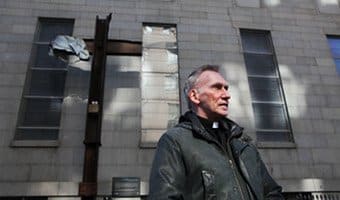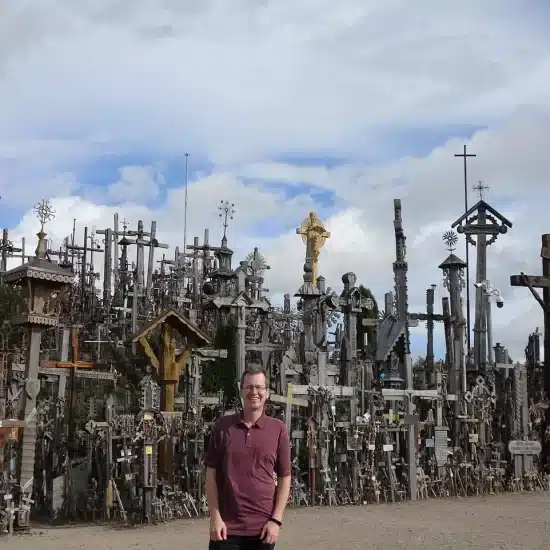NEW YORK (RNS)—The Cross at Ground Zero was one of thousands of I-beams used to construct the iron skeletons of the World Trade Center towers. This one fell from the fiery, apocalyptic heavens during the 9/11 terror attacks and stuck upright in the ground, in a field of similar but smaller crosses.

A cross formed from a falling steel I-beam at the former World Trade Center towers was placed outside St. Peter’s Catholic Church in lower Manhattan where Kevin Madigan kept watch over it until its pending move to the National September 11 Memorial & Museum. (RNS PHOTO/John Munson/The Star-Ledger)
|
The iconic cross rose higher than the others above the twisted steel, concrete slabs and human remains. When the smoke subsided and the dust and ashes settled, it emerged as a beacon—a sacred symbol of, at once, survival and remembrance.
Almost immediately, rescue workers and firefighters scratched out memorial messages on the 20-foot cross. A shrine was created; services were held.
It later was blessed and draped with a sheet-metal shroud from the wreckage, then hoisted atop a concrete stanchion from the destroyed plaza at the corner of Church and Liberty Streets. The cross stayed there until October 2006, when it was moved for preliminary construction work at the site.
“It was headed to a warehouse in Long Island, but the firefighters and construction workers objected, so we offered to put it here,” said Kevin Madigan, pastor at nearby St. Peter’s Church, the city’s oldest Catholic parish.
Soon, the cross will move again, to the National September 11 Memorial & Museum at Ground Zero.
“The way I understand it, the cross will stand in an apse, which will be built around it,” Madigan said. “So, the cross has to be in place before construction (of the apse) begins.”
The church will not be without a 9/11 cross for long. Sculptor Jon Krawczyk is making a replacement, a stainless steel “9/11 Memorial Cross.”
“It will be highly polished, so people will be able to see themselves in it and hopefully reflect on their lives, and lives lost in the terror attack,” Krawczyk said from his studio in Malibu, Calif.
Krawczyk’s 9/11 cross will have three pieces of metal saved from the World Trade Center debris.
“That metal will be used where Christ’s hands and feet would have been nailed,” he said. “Those pieces will stand out because they are rusted.”
The vertical beam of the cross will be 14 feet high, and the horizontal beam will be 11 feet wide. It’s the largest cross Krawczyk has made.
“It’s as big an honor as there possibly can be,” Krawczyk said. “I’m overwhelmed by the significance. To memorialize the sacrifice of the people and the loss of life in art, well, I’m not sure I can put it into words.”

